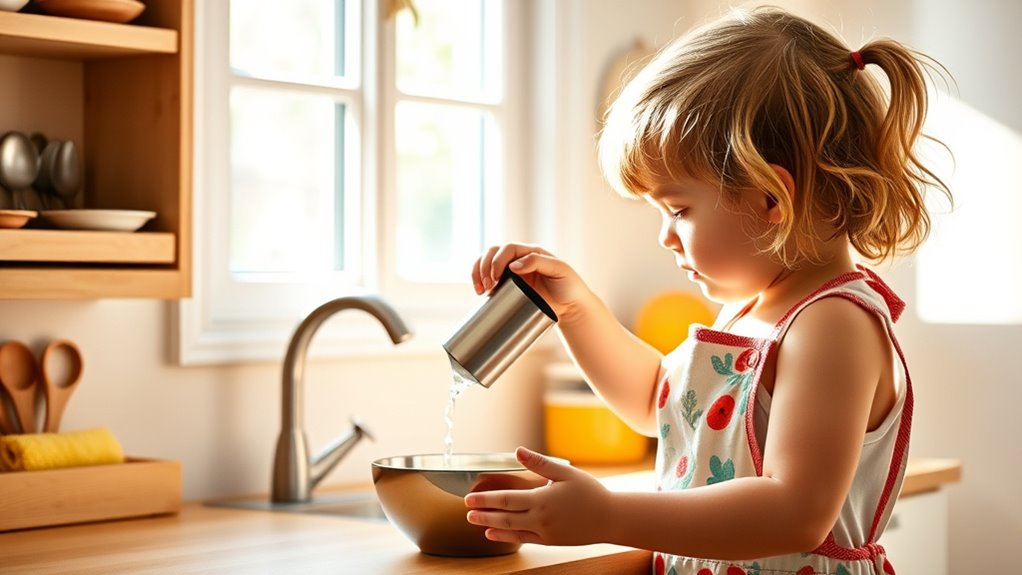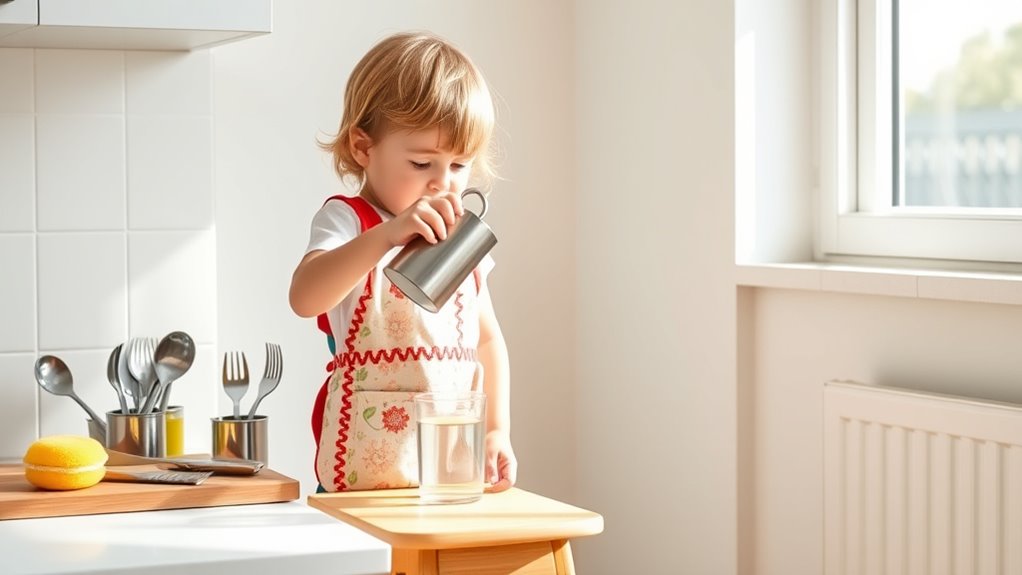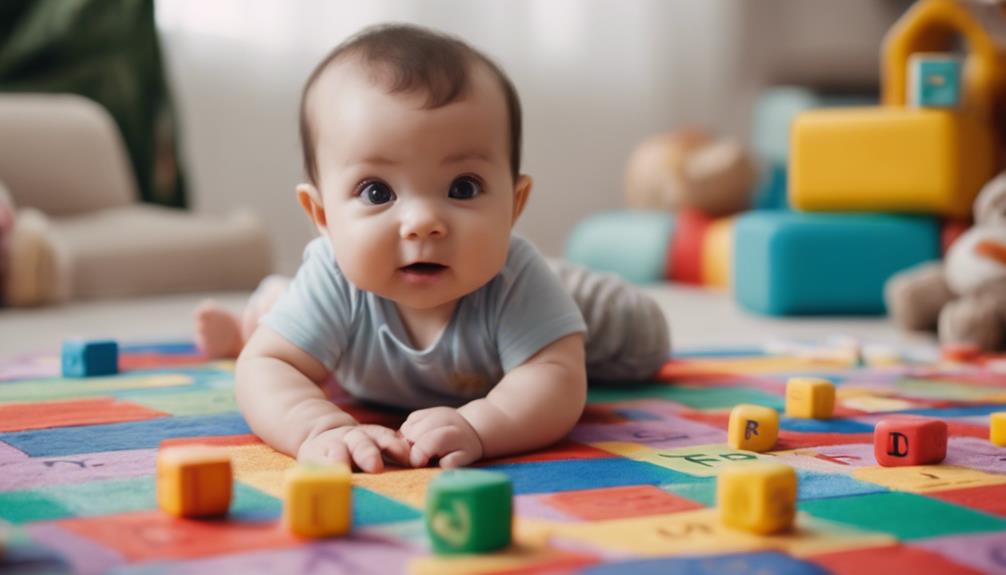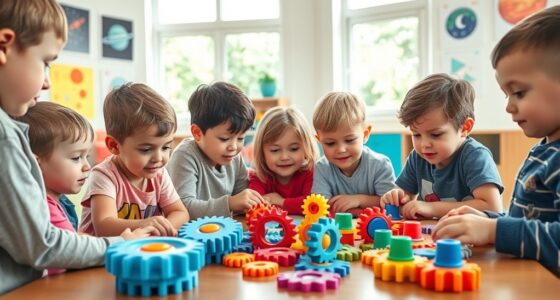To teach practical life skills at home inspired by Montessori, focus on hands-on activities that promote independence and sensor development. Tasks like pouring, dressing, and cooking can boost confidence while stimulating sensory exploration through textures, sounds, and movements. Incorporate cultural elements by preparing international dishes or using diverse utensils, fostering curiosity and respect for diversity. Keep activities engaging and meaningful to encourage enthusiasm, and explore more ideas that make learning both fun and purposeful.
Key Takeaways
- Incorporate daily routines like pouring, buttoning, and sweeping to promote independence and fine motor development.
- Use diverse textures, weights, and materials to stimulate sensory exploration and discrimination.
- Introduce cultural activities such as preparing international snacks or setting a multicultural table.
- Make tasks meaningful and engaging to foster enthusiasm and confidence in practical skills.
- Integrate technology and storytelling to enhance decision-making, cultural awareness, and holistic learning at home.

Have you ever wondered how children develop essential life skills in a natural and engaging way? One effective approach is through Montessori-inspired activities that focus on practical life skills. These activities encourage your child to learn through hands-on experiences, fostering independence and confidence. As your child engages with everyday tasks, their sensor development advances because they’re actively using their senses to explore textures, weights, and movements. For example, pouring water from one pitcher to another sharpens fine motor skills and sensory discrimination. These activities not only help children grasp real-world skills but also enhance their ability to observe and respond to their environment.
Montessori activities develop senses, motor skills, and environmental awareness through hands-on learning.
Incorporating cultural awareness into practical life activities is another crucial aspect. By introducing tasks rooted in different cultures, your child gains a broader understanding of the world. For instance, preparing a simple meal from another country exposes them to diverse ingredients and traditions, nurturing respect and curiosity about other cultures. These activities serve as a gateway for children to recognize and appreciate diversity, instilling open-mindedness from a young age. When you involve your child in setting a table with utensils and dishes from various cultures, they learn about different customs and social norms, which broadens their worldview and boosts their social-emotional development.
You can also integrate cultural awareness through storytelling, music, or art projects inspired by various traditions. These activities not only develop their sensory skills—such as distinguishing different sounds, textures, and visual patterns—but also deepen their cultural understanding. As they explore different cultural elements, they become more receptive to diversity and develop a sense of global citizenship. This approach encourages them to see the world beyond their immediate environment, fostering empathy and appreciation for different ways of life. Additionally, engaging children in mobile app breakfast ordering can introduce them to modern technological tools that facilitate independence and decision-making.
Fostering sensor development and cultural awareness through practical life activities creates a rich learning environment at home. These activities are simple to incorporate into daily routines, whether it’s helping to fold laundry, gardening, or preparing a meal. As your child practices these tasks, they refine their senses, improve their motor coordination, and develop an understanding of the world around them. This holistic approach helps children grow into confident, culturally aware individuals who are enthusiastic to learn and engage with their surroundings. By making these activities meaningful and fun, you’re laying a strong foundation for lifelong skills and a well-rounded worldview.
Frequently Asked Questions
How Can I Adapt Activities for Children With Special Needs?
When adapting activities for children with special needs, you focus on individualized adaptations and sensory modifications. You observe their unique strengths and challenges, then tailor tasks to suit their needs. Use sensory-friendly tools or adjust the difficulty level to make activities engaging and accessible. By doing so, you create a supportive environment that encourages independence and skill development, ensuring every child can participate and thrive in practical life activities.
What Safety Precautions Should I Take During Practical Life Activities?
Imagine your child pouring water, and you realize safety precautions matter. Always use safety gear like oven mitts or goggles when needed, and follow supervision guidelines closely. You should stay nearby, ready to assist, especially with sharp tools or hot items. Creating a safe environment means removing hazards and demonstrating proper techniques. This way, your child learns practical skills confidently while staying protected from potential accidents.
How Do I Introduce New Skills to Reluctant Learners?
When you introduce new skills to reluctant learners, use motivational strategies like positive reinforcement and relatable examples. Break down each skill into simple, step-by-step guidance to build confidence. Show enthusiasm and patience, encouraging curiosity without pressure. By making the learning process approachable and rewarding, you help your child feel more motivated and willing to try new practical life skills at their own pace.
What Age Is Appropriate for Starting Practical Life Skills?
You can start practical life skills at any age, but age considerations matter for skill progression. Young children as early as 18 months can begin simple tasks like pouring or dressing, while older kids handle more complex activities. Observe their readiness, and introduce skills gradually, ensuring each step matches their developmental stage. This approach promotes confidence and mastery, setting a strong foundation for lifelong independence and learning.
How Can I Incorporate Cultural Diversity Into Activities?
You can incorporate cultural diversity into activities by celebrating cultural celebrations and including diverse materials. Use recipes from different countries, introduce traditional clothing, or explore music and dance from various cultures. Incorporate toys, books, and art supplies that reflect different backgrounds. This not only enriches your child’s understanding of the world but also fosters respect and curiosity for other cultures through engaging, hands-on experiences.
Conclusion
By incorporating Montessori-inspired activities into your daily routine, you help your child develop independence, confidence, and responsibility. You teach patience, foster curiosity, and build resilience—all through simple, practical tasks. You create opportunities for growth, encourage exploration, and nurture a love for learning. You empower your child to navigate the world with skills, self-reliance, and joy. And in doing so, you lay the foundation for a lifetime of success, independence, and fulfillment.










